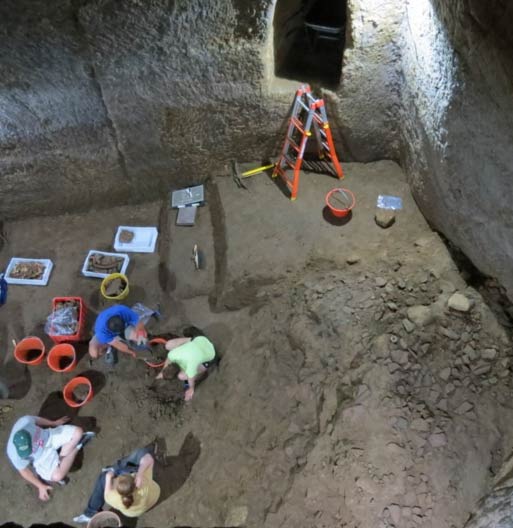When archaeologists discovered the first ever Etruscan pyramid-like buildings under a city in Italy, they were at a loss to explain the mysterious structures.
Three years ago a team of U.S. and Italian archaeologists began excavations under a wine cellar in Orvieto, Italy, after identifying stairs carved into a wall as Etruscan style. As they dug through mid-20th century and medieval walls and floors, they encountered tunnels and caves. These large chamber walls were carved to slope up in a pyramidal shape.

Etruscan Pyramid columbarium, used as a working lab, and filled with artifacts. Credit: Daniel George, Jr./Popular Archaeology
Popular Archaeology reports on the initial reactions of Prof. David B. George of St. Anselm College and Claudio Bizzarri, co-director of PAAO ( Parco Archeologico Ambientale dell’Orvietano ) and colleagues, “We discovered it three summers ago and still have no idea what it is. We do know what it is not. It is not a quarry; its walls are too well dressed. It is not a well or cistern; its walls have no evidence of hydraulic treatments.”
The Etruscans created and shaped many subterranean paths and cave chambers, but until this discovery none had ever been found that were in such a distinctive form, with a narrow apex that slopes and widens into a square base.

Archaeology team excavates the Etruscan ‘Pyramids’. Credit: Daniel George, Jr./Popular Archaeology
Etruscans are largely an historical enigma, emerging as a sophisticated culture around 900 BC in central Italy, and bringing art, fine metalworking, commerce, and writing to Europe and the Mediterranean. However, the society did not survive, and they were blended into the Roman empire, leaving few clues as to their culture.
Dubbing the underground pyramids ” cavitá” (Italian for ‘hole’ or ‘hollow’), archaeologists have thus far managed to reach about 15 meters (49 feet) down. Much of the site had been intentionally backfilled in ages past for reasons unknown. Clearing the fill material has revealed many artifacts. According to Popular Archaeology, David B. George and colleagues have described the finds; “We know that the site was sealed toward the end of the 5th century BCE. It appears to have been a single event. Of great significance is the number of Etruscan language inscriptions that we have recovered – over a hundred and fifty. We are also finding an interesting array of architectural/decorative terra cotta.”

A medieval chamber for raising pigeons, called a columbarium, filled with excavated pottery. Credit: Daniel George, Jr./Popular Archaeology
Excavations on the cavitá and related sites have produced ceramic materials, large basins, Attic red figure pottery, and more. In all, Claudio Bizzarri believes at least five similar pyramids exist beneath the city.
The mystery of the Etruscan pyramids continues to perplex researchers, with guesses as to their purpose including religious structures, or tombs. Bizzarri told Discovery News , “Most likely, the answer waits at the bottom. The problem is we don’t really know how much we have to dig to get down there.”